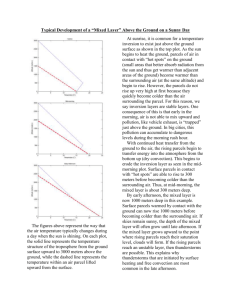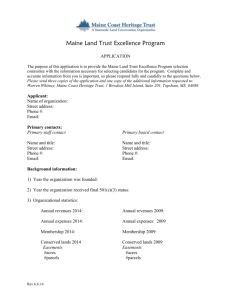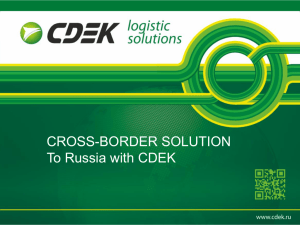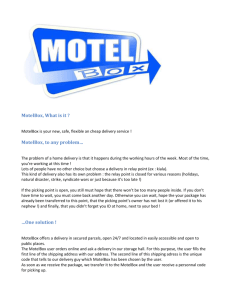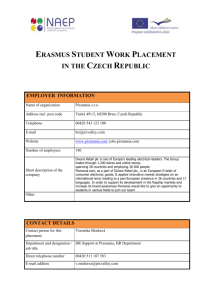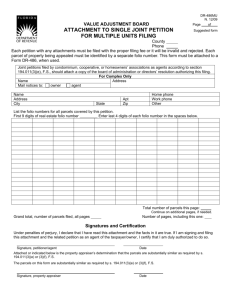the uk market for 3 rd party b2c e-fulfilment
advertisement
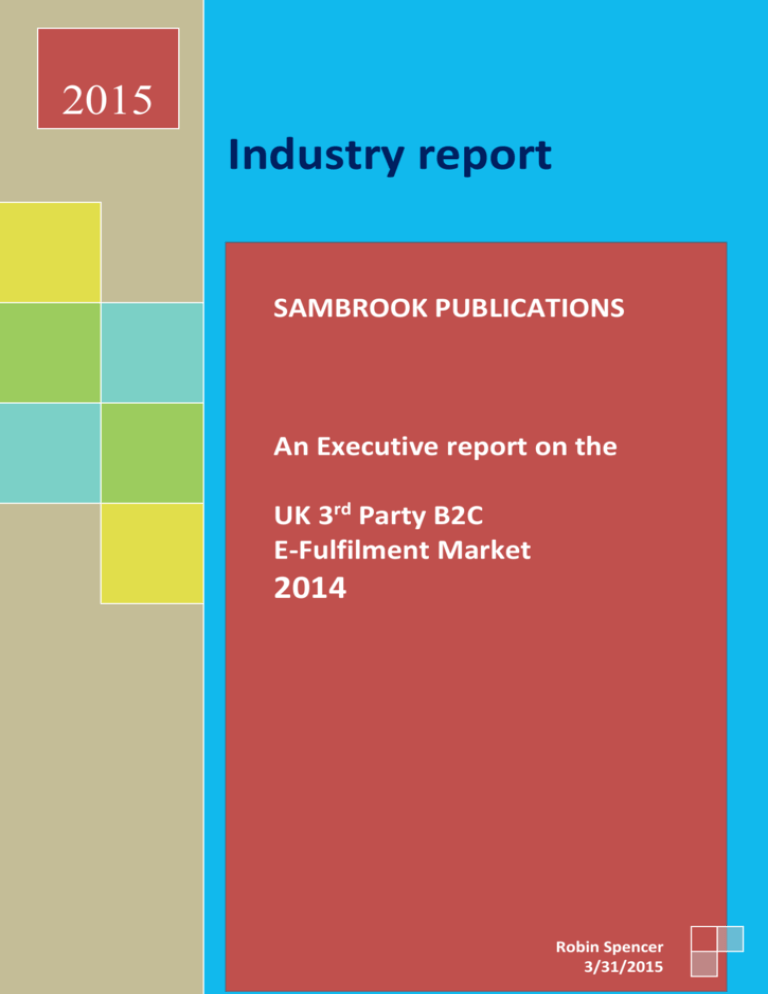
2015 Industry report SAMBROOK SambrookPUBLICATIONS Research International An Executive report on the rd UK 3PUBLICATION Party B2C E-Fulfilment Market THE UK MARKET 2014 for B2C 3RD PARTY E-FULFILMENT Sambrook Research International Wellbank Research Centre Pickstock, Newport Shropshire TF10 8AH England Ref : 326 / 12 11th November 2012 Tel 01952 551188 Fax 01952 551163 E-mail : robin.spencer@sambrookresearch.co.uk Robin Spencer 3/31/2015 Contents Table of Contents EXECUTIVE MANAGEMENT SUMMARY .................................................................. 1 INTRODUCTION – OBJECTIVES, METHOD, SAMPLE ........................................... 2 BACKGROUND AND OBJECTIVES OF THE RESEARCH PROJECT ......................................................................... 2 THE UK MARKET FOR 3RD PARTY B2C E-FULFILMENT ..................................... 3 MARKET SIZE, PAST AND FUTURE ................................................................................................................... 3 APPENDIX .......................................................................................................................... 8 A NOTE ABOUT SAMBROOK RESEARCH INTERNATIONAL ............................................................................... 8 EXECUTIVE MANAGEMENT SUMMARY Background, overall research objectives and methodology The UK is acknowledged as having one of the most advanced e-commerce structures in the world, and the total e-commerce market is estimated by some to be worth over £100 billion. Although there is much data for the overall e-commerce market, there does not appear to be any readily available data for niche sectors such as 3rd party B2C e-fulfilment. This report aims to fill that gap in knowledge, the key objectives being: 1. Market size for 3rd party B2C e-fulfilment (volume / value), past and future trends 2. How the market segments by key product sector fulfilled 3. An analysis of the supply structure for 3rd party e-fulfilment services Methodology Desk research was followed by 10 in-depth qualitative interviews with large providers of 3rd party e-fulfilment services Summary of key findings 1. The market for 3rd party B2C e-fulfilment is estimated to be worth £2.56bn in 2014 with 333m parcels being delivered, having grown by 12.9% from 295m in 2013. The market is expected to grow slightly slower at 11.5% pa to 450m parcels by 2017. 2. Key drivers for growth over the last 12 months have been Multi-channel / omni-channel marketing to mobile devices now become mainstream Click and collect established as major marketing tool for many retailers Multiple delivery options became well embedded in online marketing Enhanced returns processing now a critical issue for fashion and some other sectors Rapid delivery, especially free next day delivery, is now generally the norm 3. Key drivers for growth expected in the next 3 years, as well as the following Further growth of enhanced delivery options and next / same day delivery Further growth of omni-channel marketing and purchases from mobile devices Continued development in returns management sites, especially for clothing / fashion Growing scale and impact of high peak sales points such as Black Friday 4. What e-fulfilment suppliers need to do to succeed in the next 3 years Plan appropriate flexibility and agility to meet massive peaks in demand Develop e-fulfilment service to meet customers’ delivery expectations Develop sophisticated and effective returns processing systems 5. Fashion / clothing is the largest product group e-fulfilled accounting for 100m parcels in 2014 and forecast to grow strongly at 12.5% pa to around 142m parcels by 2017, but return rates will remain high at an average of 20-25%. Other product groups are general domestic merchandise - 78m parcels, growing to 107m by 2017, consumer electrical products - 50m parcels with slower growth to 67m parcels by 2017, media products - 22m parcels expected to decline to 20m by 2017, and other miscellaneous products - 83m parcels and expected to grow steadily to 114m parcels by 2017. 6. About 12 e-fulfilment suppliers deliver an estimated 201m B2C parcels (60% of the total), a further 55 suppliers deliver 72m parcels (21%) and up to 750 smaller suppliers deliver 60m parcels. However the top 12 suppliers account for just over 75% of the market by number of items delivered and by WPP income. 1 INTRODUCTION – OBJECTIVES, METHOD, SAMPLE Background and objectives of the research project The aim is to provide a reliable estimate for the size of the UK market for 3 rd party B2C efulfilment services (by volume and value), an analysis of past and future trends, how the market segments by key product group and the supply structure for e-fulfilment. Background, The UK is acknowledged as having one of the most advanced e-commerce structures in the world, and the total e-commerce market is estimated by some to be worth over £100 billion. However, there are many aspects of e-commerce, including downloads of nonphysical items such as music, online supermarket goods delivered from local stores, inhouse e-fulfilment and 3rd party e-fulfilment (both B2C and B2B). B2C e-fulfilment has experienced significant growth in the last 3 years, with retailers and manufacturers either managing the fulfilment of ‘e-commerce’ orders using in-house facilities or by using 3rd party e-fulfilment service providers. Research objectives Although there is much data for the overall e-commerce market, there does not appear to be much readily available data for niche sectors such as 3rd party B2C e-fulfilment, which although considered by some to be a sub- sector, it is also clearly a significant market in itself. Sambrook research published market reports on the UK 3rd party B2C e-fulfilment in 2012 and 2013 This report is an update for the market in 2014. The main objectives of the report are as follows: 1. 3rd party B2C e-fulfilment market size (volume / value), trends in 2014, future trends 2. How the market segments by key product sector fulfilled, trends in 2014, future trends 3. An analysis of the supply structure for 3rd party e-fulfilment services Methodology and sample The research method was based on desk research, review of relevant literature and reports on e-commerce / e-fulfilment and in-depth interviews with large 3rd party B2C e-fulfilment suppliers. An overview of the sample interviewed is shown below. E-fulfilment suppliers Total 10 2 THE UK MARKET FOR 3RD PARTY B2C E-FULFILMENT Market size, past and future The market for 3rd party B2C e-fulfilment is estimated to be worth £2.56bn in 2014 with 333m parcels being delivered, having grown by 12.9% pa from 295m in 2013. The market is expected to grow slightly slower at around 11.5% pa to 450m parcels by 2017. Market definition For the purpose of this report, the market is defined as “the order fulfilment of physical items purchased by consumers, with the products being stored in warehouses, picked and packed by 3rd party contractors and delivered (by them or independent couriers) to a nominated address (UK or overseas) or to a store for collection (i.e. click and collect)”. The e-fulfilment service may involve the retailer or the e-fulfilment company providing the warehousing and e-fulfilment software system. Returns handling is also included. However, the market (for the purpose of this study) excludes all inter store deliveries (elogistics), e-commerce of non-physical items such as downloadable music, deliveries of products such as groceries delivered from store to consumer, fulfilment of POS marketing materials / products, catalogues, brochures, and in-house e-fulfilment i.e. the retailer or manufacturer does the e-fulfilment rather than an external 3rd party supplier. Market size by volume (parcels) UK 3rd Party B2C e-Fulfilment Market (million parcels despatched pa) 500 400 300 450 200 100 295 333 2013 2014 0 2017 Source – desk research and interviews There was consistent feedback that the 3rd party B2C e-fulfilment market grew strongly over the last 12 months. Our analysis estimated the market to be 333m parcels in 2014 (containing 1 billion items), having grown by 12.9% from 295m parcels in 2013. There was a general consensus that future growth rates would be slightly slower at around 11.5% pa for the next 3 years, although higher in some sectors (clothing / fashion in particular). Hence, the market is forecast to grow to 450m parcels by 2017. The overall value of the 3rd party B2C e-fulfilment services market (i.e. including warehouse facilities and management, e-fulfilment system, pick and pack, delivery (by courier or post), returns handling and added value services such as gift wrapping, returns repairs (damaged goods / packaging) or e-commerce / website design services, etc.) in the UK is estimated to have grown from £2,255m in 2013 to £2,560m in 2014. 3 The key drivers of growth in 2014 (in approximate order of importance) were as follows: Multi-channel / omni channel marketing is now one of the key drivers attracting online customers, especially purchases from mobile devices such as tablets and mobile phones, and ‘mobile commerce’ is now considered by some respondents as being mainstream. Click and collect became a major factor for many larger retailers in 2014, which have successfully promoted this and persuaded consumers to visit stores to collect their goods, where they often make additional top-up purchases. However, smaller regional / local retailers do not appear to be as strongly involved. Offering multiple delivery options was also one of the key drivers in 2014, so customers can choose the optimum delivery solution (often to a site where they collect) that is most convenient to them. A wide range of options is often available, which includes delivery to home / office, to drop boxes, lockers, tube stations, post offices, petrol stations and in-store collection sites at other retailers such as Argos as well as retailers own click and collect. Enhanced returns processing systems / sites, especially in clothing / fashion sector where return rates are high but also other sectors, with specialist e-fulfilment suppliers developing designated facilities that are geared to manage refunds quickly, efficiently return suitable items back into stock and dispose of damaged stock in a cost efficient manner. Some respondents think ‘returns management’ is the new battle ground. Fast delivery is generally the norm, with many retailers offering ‘free’ next day delivery. E-fulfilment suppliers say that next day delivery on their tender quotes has replaced the 5-7 days delivery that was common in the past. In addition, there has been a continuing trend towards narrow delivery window time slots as well as extending when deliveries take place, i.e. evening / weekend deliveries that are convenient for customers. Key future drivers for the next 3 years (in approximate order of importance) are as follows. There will be a continued trend towards e-commerce purchases in the next 3 years and some of the expected drivers of future growth mentioned in discussions were similar to those for 2014. The following bullet points summarise the key drivers that are related to the anticipated slight slowdown in market annual growth rate, as well as different drivers that are emerging and existing drivers that are expected to grow in importance over the next 3 years. Growing trend to provide enhanced delivery options that are convenient to the customer. Next day delivery will become the default option (with no extra charge to the customer) and same day delivery for major cities (such as London) will probably be introduced by leading brands (following the trend already emerging in Seoul, South Korea). Other trends will include tighter delivery windows (trending towards a 1-hour slot), and a continued expansion of delivery options to local pick up sites convenient to the customer. Omni channel marketing (especially to mobile devices such as tablets and mobile phones) and click and collect will continue to develop strongly to promote online shopping. Continued development of efficient returns management systems / sites, especially in clothing / fashion sector, where return rates are high, with specialist e-fulfilment suppliers developing designated facilities that are geared to manage refunds and returns into stock quickly and efficiently, as well as developing innovative solutions to disposing of damaged stock to optimise the commercial yield of these items for the retailer. Growing scale and impact of high peak sales points, such as Black Friday, as retailers use these events to shift excess stock and initiate momentum in consumer purchases. 4 What e-fulfilment suppliers need to do to succeed in the next 3 years Respondents were asked “What are the key issues that 3rd party B2C e-fulfilment suppliers need to address in order to succeed in the next 3 years (2015-2017)?” Their suggestions are summarised below. Plan in appropriate flexibility / agility to meet massive peak demands (5 mentions). These plans should be tried and tested, and able to meet the massive peaks such as Black Friday and Cyber Monday, and spectacular growth suddenly achieved by major accounts (some successful clients can achieve >50% volume growth in a single year) as well as smaller seasonal peaks or clients’ sales promotions. Sound contingency plans should be prepared, embedded, ready for implementation, and address all aspects including labour, property, warehouse pick and pack systems, and processing returns levels and customer refunds (where relevant). Develop an e-fulfilment service to meet consumers’ expectations (3 mentions) – especially the ability to have the right in-house order processing capabilities and partnerships with the right carriers, so you are able to meet tight delivery expectations (especially next day and possibly same day delivery in the coming years). Develop sophisticated and effective return processing systems (2 mentions) – with the ability to demonstrate to retailers that not only the number of items returned into stock is optimised, but also offering innovative ways to dispose of non-sellable returns, such as component stripping or selling through alternative sales platforms, and show how this maximises the income yield for the retailer. Other suggestions were mentioned once each. Identify suitable warehousing – new schemes are in the pipeline and e-fulfilment suppliers need to identify sites that are in the right place, of the right size at the right price. Plan to scale up facilities and put the economies of scale that are achievable into future sales propositions. Keep abreast of the latest developments in warehouse technology and mechanisation. Develop a flexible approach towards staff, especially in regards to planning for the strong growth in demand and especially the peaks in demand that occur throughout the year. This approach should embrace all staff – permanent and temporary staff, pick & pack teams and their managers, through careful recruitment and personal development training programmes. Where possible, seek to develop longer term contracts with major accounts, to ensure that ROI and payback on large scale investments can be achieved with reduced risk. Identify what will be the next trend after omni-channel, and understand how e-fulfilment companies need to proactively help retailers develop the next sales and marketing initiatives that will drive the next wave of consumer purchases towards online shopping. Maintain an acceptable level of profitability whilst at the same time investing in appropriate warehouse pick & pack and processing software systems. 5 3rd party B2C e-fulfilment volume segmentation by 5 broad product groups Parcels despatched in 2014 (millions) 100 Clothing / fashion 78 General merchandise 50 Consumer electricals 22 Media 83 Other miscellaneous 0 20 40 60 80 100 Clothing / fashion This sector has is estimated to have grown strongly by 15% from 87m parcels in 2013 to around 100m parcels in 2014. Return rates are also the highest of all product sectors, most estimates ranging from 20% to 40%, and 25% is considered about average for this sector. The clothing / fashion sector is forecast to grow slightly faster than the market average, probably around 12.5% pa, to 142m parcels by 2017. General domestic merchandise / giftware This sector is thought to have grown faster than overall market growth, by 13.5%, from 67m parcels in 2013 to 78m parcels in 2014. A growth of around 12.5% pa (slightly faster than overall market growth) is forecast for this sector, i.e. to around 107m parcels by 2017. Consumer electrical products Consumer electrical products are estimated to have grown slightly slower than the overall market in 2014, i.e. by 11.5% from 45m parcels in 2013 to 50m parcels in 2014. Growth rate in this sector as a whole is forecast to be lower than the overall market at around 10% pa over the next 3 years, i.e. growing to an estimated 67m parcels by 2017. Media B2C sales of media products are thought to have remained static over the last 12 months, with a slight revival in book sales (notably by companies such as Waterstones) balanced by a decline in other media as many people now prefer to download media online. The consensus view is that e-fulfilment sales levels will probably decline slowly by about 10% over the next 3 years from its current level of 22m parcels to 20m parcels by 2017, Hence its market share will fall from 6.6% to 4.5%. Others This sector includes a wide range of products, including some large groups such as toys, DIY products, cosmetics & toiletries, as well as fitness products, personal items, jewellery, femcare, baby care products and garden products. This sector is thought to have grown 12.5% pa from 74m parcels in 2013 to 83m parcels in 2014, and is forecast to grow at 11.5% pa, to around 114m parcels by 2017 6 How the market segments by size of e-fulfilment supplier. Large suppliers (3m or more parcels pa) Medium sized companies (0.5-2.9m parcels pa) Small companies (<0.5m parcels pa) Total Parcels despatched per annum (m’s) 201m 72m 60m 333 million % market share 60.4% 21.6% 18.0% 100% Source – desk research and in-depth telephone interviews Note – in the above table, large medium and small is used solely in relation to each company’s involvement in the B2C 3rd party fulfilment market, and it is acknowledged that for many, this is only a small part of their operation. For the purpose of this report, large companies comprise those that despatch more than 3m parcels a year, medium sized companies despatch 0.5-3m parcels, small companies despatch less than 0.5m parcels a year. In order to establish a reliable estimate of the market size, the supply structure was segmented into three categories according to the number of B2C parcels that suppliers fulfil each year, and a matrix analysis was used to estimate the size of the market for 2014. Large B2C e-fulfilment companies (>3m B2C parcels pa) This group of about 12 companies comprises of some suppliers that are focused on full service (mostly multi-client facilities), where the e-fulfilment company provides the warehousing, the e-fulfilment software, pick and pack, and in most cases the courier service (albeit through 3rd party providers). It also comprises companies that provide a mix of full service e-fulfilment, as well as ‘basic’ e-fulfilment, often client-dedicated sites where e-fulfilment is mainly pick, pack and / or returns handling, and the retailer sometimes owns the warehouse and e-fulfilment software system which the e-fulfilment company operates and manages. Most large suppliers have grown steadily, with growth rates in the region of 10-15% over the last 12 months, a couple have grown faster and two suppliers lost significant market share, either because they lost accounts to competitors or because customers decided to cease outsourcing their e-fulfilment. Overall, it is estimated that large companies delivered 201m parcels in 2014 (60.4% market share) but account for over 75% of the number of items despatched each year and WPP revenue generated. Medium-sized B2C e-fulfilment companies (0.5-3m B2C parcels pa) There are an estimated 50-60 medium sized companies that are thought to have grown in slightly faster than average market growth, i.e. 15%, and are therefore estimated to have delivered 72m parcels in 2014 (21.6% market share). Small B2C e-fulfilment companies (< 0.5m B2C parcels pa) There are an estimated 200 small B2C e-fulfilment companies (delivering 10,000-500,000 parcels pa) and a further 500 or so very small suppliers (delivering <10,000 parcels pa). This sector is thought to have grown slightly faster than the overall market growth, i.e. an average of 14%, mainly as a result of strong growth in small / very small retailers either developing internet sales for the first time or outsourcing their e-fulfilment from in-house as their internet sales are growing so strongly. These retailers find the very small efulfilment companies are more geared to their needs. This group is therefore estimated to have grown from 53m parcels in 2013 to 60m parcels in 2014 (18% market share). 7 APPENDIX A note about Sambrook Research International Sambrook Research specialises in B2C and B2B market strategy research and has a strong track record evaluating market size / segmentation / trends studies across a wide range of diverse industry sectors, as well as customer needs and performance studies. Broad industry experience 80 Transport Chemical/mineral/metal Construction / building Healthcare 63 61 58 45 Sambrook Research specialises in B2C and IT / electronics / telecom 45 Packaging / plastics B2B market strategy research. Over the last 36 Energy / utilities 28 24 years we have successfully completed Engineering machinery 28 Consumer goods over 480 projects, about 75% of which 15 Banking / finance 30 involved researching business-to-business Other serv ices / projects 0 25 50 75 100 markets across a wide range of diverse Number of projects industrial & commercial sectors. The most frequently researched sectors are transport (80 projects), chemical / mineral / metal goods (63), construction / building industry (61), healthcare (58), packaging / plastics (45), IT / electronics / telecommunications (45), energy / utilities (36), engineering machinery / equipment (28), consumer products (28), banking/finance (15) other service sectors (30). UK and International experience Over 40% of the projects we carry out involve researching International markets. Europe is the most researched region, UK 58% accounting for 27% of projects – about half are panEuropean studies and half researching specific countries. North America (including the USA) accounts for 7% of ROW 3% projects and the rest of the world is mainly Asia and the Far World-wide 5% East, with a few projects in the Middle East and Africa. North America 7% About 5% of the projects carried out have involved a worldEurope 27% wide market study with primary research carried out in several continents. Team members are fluent in all the key European languages. Key types of research project undertaken Market sizing, past/future trends, segments, supply structure / market share, strategy recommendations Attitudinal studies - end-user needs / requirements of suppliers (in terms of product, service, price, etc.) Image, performance vs customer needs, benchmarking client organisation compared to key competitors New product/concept test – main likes/dislikes, suggestions to improve, likely future buying intentions Acquisition studies – due diligence, market sizing/segments, image/performance of target company Diversification studies – brainstorming, identifying potential new market opportunities, research market size/segments/trends, key competitors, specific end-user needs, organic growth or acquisition options For further information, or to discuss a potential research project contact: Robin Spencer, Partner, Sambrook Research, Wellbank Centre, Pickstock, Shropshire, TF10 8AH. Telephone 01952 – 551188 or email: robin.spencer@sambrookresearch.co.uk. Website: www.sambrookresearch.co.uk 8

